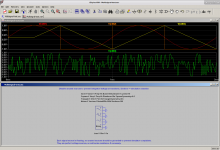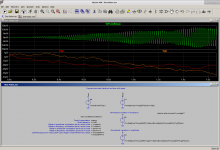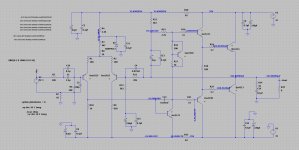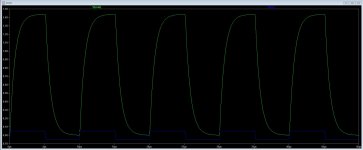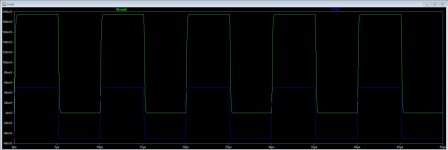Best way to learn any program is to be instant messenger buddies with someone who knows how to use it...
It is just boring and unnecessary complicated for what we need most of the time: A simple square wave generator with the fastest rise and fall time available to see overshoots in our circuit. As sin. gen.: Just to set the frequency.You use the 'Pulse' option to define any squarewave you want to create. It gives total control over rise and fall times as well as on/off period.
Post #31:
https://www.diyaudio.com/forums/sof...g-ltxvii-beginner-advanced-2.html#post4032832
I'll have a look.Go here Ngspice, the open source Spice circuit simulator - Intro and do your best 🙂
Here is a signal generator. The symbol and internal schematic are in the zip file, they must both be in the same folder as the schematic you want to use it on. I recommend opening Multisignal-test.asc and copying the generator there to your schematic.
Attachments
Thanks. I've been posting my Ampsim rig for years and no one ever used it, so I figured I would try a different tactic. I wonder if anyone will use this? BTW, I've been tweaking these generators for years, there are subtle things that make the operation less buggy.
I could break it up into individual sources, but I would rarely use it that way. Maybe I should mimic the Microcap generator symbols?
With all the sources together like this, you can do stuff like put the sine and square in series to test for ringing at peaks.
I could break it up into individual sources, but I would rarely use it that way. Maybe I should mimic the Microcap generator symbols?
With all the sources together like this, you can do stuff like put the sine and square in series to test for ringing at peaks.
Thanks a lot, keantoken.Here is a signal generator. The symbol and internal schematic are in the zip file, they must both be in the same folder as the schematic you want to use it on. I recommend opening Multisignal-test.asc and copying the generator there to your schematic.
I will use-it, for sure. Exists-it a way to add-it to the components Of LTSPice, to can use-it directly like the internal "Voltage" ?
Last edited:
I would think it would be very useful as it really is a very neat idea. I'm out of time for today but I'll hopefully have a go at trying it in a real sim tomorrow.
HTML:
Thanks a lot, keantoken.
I will use-it, for sure. Exists-it a way to add-it to the components Of LTSPice, to can use-it directly like the internal "Voltage" ?
I was going to update it for that, but I wanted to wait until people had tested it in case I need to make some changes.
Hi,how do you set up a square wave simulation for three different frequencies, 100, 1000 and 5000 Hz? thank you
The simplest way is to simulate 3 times, changing the square wave each time.
If you're using my generator, you can use Fsq=F and then add this to the schematic:
.step param F list 100 1k 5k
If you're using my generator, you can use Fsq=F and then add this to the schematic:
.step param F list 100 1k 5k
Last edited:
I cannot understand such a program like LTspice, free or not, text based, can exists in the 21th century.Still, just try using any other other free simulators.
All users spend thousand of hours to change the parameters at each new simulation change, it is tricky to get the good compromise between speed and accuracy... while all this work would be done once and for all via a GUI interface, changing all the needed parameters with a simple clic.
I am angry every time I have to use it with all the time I lose, and am never sure of the results because I probably forgot to change an important setting, like simulation time etc.
It is a tool, we, users, are interested in the results, not to learn how to be specialists in this tool manufacture.
A shame. A real shame !
Last edited:
You can't have it all. You can only identify your needs and find out what are the best available options to meet those needs. The amount of time and energy that needs to be invested may be more than you expected, but that doesn't necessarily mean your or the programmer's effort is wasted.
Your signal generator is an example. An other one is the parameters that you enter in transients via UI are copied the wrong way in AC. You have to re-enter them each time you swap from an analysis to an other.You can't have it all. You can only identify your needs and find out what are the best available options to meet those needs. The amount of time and energy that needs to be invested may be more than you expected, but that doesn't necessarily mean your or the programmer's effort is wasted.
About the development time, I was developing under C++, VBS, Delphi, PHP, Javascript etc. So, I have a little idea ;-) it takes a little time, but it is constructive as your efforts are not wasted.
The fact that the parameters are in the same file than the schematics is stupid and ugly. People like Mooly or you spend hours in explaining all the trics needed to make this program working correctly that could be implemented by default. And that do not imply you miss all the flexibility, because you can always modify the comportment manually.
An other example is the components models. Why the efforts of the users, like Cordels ones are not included in the program by the community ?
In fact, and i'm sure you will not contradict-me, the UI is such a miss that most people prefer to enter the parameters manually.
This program is able to make amazing miracles. Is-it too much asking that numdgt, numcyc, dlycyc, simtime, dlytime, timestep, prb to be calculated by the program itself, in order to be optimal (fastest while accurate enough) depending on the result you want to see (waves forms, distortion, FFT etc.) and the frequency ?
Last edited:
Hello all again. Is there any way to simulate random variations in time and or in frequency and or in amplitude from the voltage sources available in the LTS4?. I want to test a tube voltage regulator composed by a 6B10 cascoded and a 6FM7 as series pass element. Many thanks in advance.
This program is able to make amazing miracles. Is-it too much asking that numdgt, numcyc, dlycyc, simtime, dlytime, timestep, prb to be calculated by the program itself, in order to be optimal (fastest while accurate enough) depending on the result you want to see (waves forms, distortion, FFT etc.) and the frequency ?
There are clearly ways LTspice could be better. If you can make a better frontend using LTspice as a backend, that would be marvelous. But as things stand there is no persuading other people to do it. Those other people have probably already given as much as they can justify for free without some form of material compensation.
Hello all again. Is there any way to simulate random variations in time and or in frequency and or in amplitude from the voltage sources available in the LTS4?. I want to test a tube voltage regulator composed by a 6B10 cascoded and a 6FM7 as series pass element. Many thanks in advance.
You have to use expressions in b-sources. Here is an example.
Attachments
Version IV is absolutely fine wrt to UI. The new one is a bitch, though. Bloated with useless and buggy features, namely those 'editors' and that major screw-up with the sim command UI. Just stay away from it would be my recommendation.
I like it exactly because it is so low-level and bare-bone, yet extremely capable.
I like it exactly because it is so low-level and bare-bone, yet extremely capable.
Ok, with such an enthusiasm, I give-it up. You have convinced me.But as things stand there is no persuading other people to do it. Those other people have probably already given as much as they can justify for free without some form of material compensation.
I am only involved in community work on open source freewares. There is no fun working alone and, anyway, I'm not experienced enough with LTspice to do-it all by myself and get the best results.
Sad times where money is the last unique motivation and "material" the only value, individualism at its peak.
Last edited:
Version IV is absolutely fine wrt to UI. The new one is a bitch, though. Bloated with useless and buggy features, namely those 'editors' and that major screw-up with the sim command UI. Just stay away from it would be my recommendation.
I like it exactly because it is so low-level and bare-bone, yet extremely capable.
Except that the ongoing improvements in transistor models and simulator engine are only available in the current version.
Hi, I'm am a beginner and I don't know if the right place to ask, but I try. I'm doing simulations of an amplifier found on the internet in which I have replaced the transistors with others similar already owned. By doing square wave simulations I got poor results. Only by modifying the gain resistance R11 to 2K does the square wave adjust itself, but obviously I lose amplification power. How can I do to solve the problem? I attach diagram and graphs.
Thank you
Thank you
Attachments
- Home
- Design & Build
- Software Tools
- Installing and using LTspice IV (now including LTXVII), From beginner to advanced
